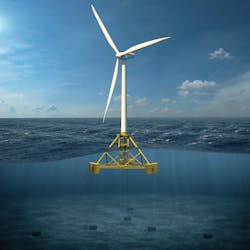Offshore staff
OSLO, Norway – DNV is leading a research project in Britain funded by Innovate UK, in cooperation with the US National Offshore Wind Research & Development Consortium (NOWRDC).
The program, which will continue through March 2023, is investigating the use of wake steering on floating wind farms. Project teams are involved on both sides of the Atlantic.
In the UK, DNV, Durham University, and Marine Power Systems (MPS) are combining their experience in wind resource, wake modeling, wind farm control, floating platform design and economic modeling for the CONFLOWS (CONtrol of FLOating wind farms with Wake Steering) project.
The US team, led by the National Renewable Energy Laboratory (NREL), in partnership with Cornell University and Equinor, is focusing on regions of North America with potential for offshore wind. They will perform optimization studies using wind farm control.
The economic analysis should provide an overview of the impact of wake steering techniques in offshore floating wind farms, and whether this can help lower project costs.
Both consortia will share data and knowledge for the modeling of site-specific meteorological conditions and wind farm wake scenarios.
Wake steering is a process that attempts to deflect each turbine’s wake away from downstream turbines, allowing increased overall power production, and a longer turbine lifespan through reduced fatigue damage.
Hywind Scotland, the world-first floating offshore wind farm, achieved a levelized cost of energy (LCoE) of £180/MWh ($248/MWh), but the typical LCoE of a fixed offshore wind farm in the UK is said to be much lower, at £55/MWh ($75.7/MWh).
Graham Foster, chief technical officer at MPS, said: “The floating foundation used for this study uses a tensioned mooring that provides a fundamentally more stable platform against which control forces can be applied and resists twist compared to catenary moored platforms.
“This technology could be more suitable to support wake steering for optimizing the wind farm output.”
Use of wake steering, estimates suggest, could allow an average-sized wind farm to realize a gain of more than 1% in annual energy production, a significant factor for asset financing.
DNV will also continue development of LongSim, a dynamic wind farm simulator and optimizer for wind farm control applications.
Durham University will lead the development of steady-state wake steering models and calibrating these against high-fidelity data.
Finally, MPS will focus on the sizing of its WindSub floating platform to support the reference NREL 15-MW horizontal axis turbine, also performing modeling of the entire system using OrcaFlex software.
07/08/2021




